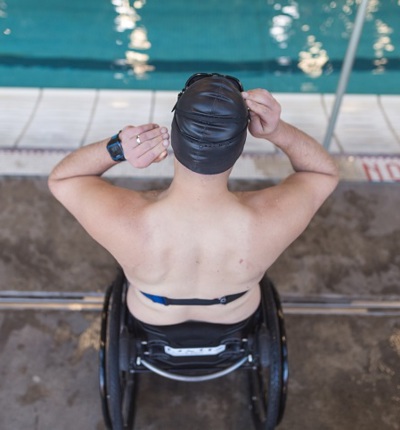
Spinal Cord Injury Awareness Day
Charlotte Cooper, explains the different types of spinal cord injuries and what support can be given to make sure that those injured have a home that accommodates their injury
Posted on 17 May 2019
Spinal Cord Injury Awareness Day is an annual event arranged by the SIA (Spinal Injuries Association) and other spinal cord injury charities. The aim of the day is to raise awareness and increase understanding about spinal cord injuries specifically their impact, effect and treatment.
What is the Spinal Cord?
The spinal cord is a long tube-like structure which runs from the base of the head to around the waist. The cord is housed by rings of bone called vertebra which make up the spinal column. The spinal column is divided into sections relating to their location in the spine; the cervical spine (neck), thoracic spine (chest), lumbar and sacral (waist). Each section has a series of vertebra numbered “1” at the top, counting downwards, so for example the top vertebra in the cervical spine is C1 counting down, C2, C3 etc. and T1 is the top vertebra in the thoracic spine.
The spinal cord carries messages back and forth from the brain via nerves called upper motor neurons (UMNs). Nerves called lower motor neurons (LMNs) branch out from the spinal column to carry messages to the outer parts of our bodies, for example telling us to move our legs to walk and sending messages back to the brain, for example the feel of an object when we touch it.
What is a Spinal Cord Injury?
An injury to the spinal cord is damage to the cord itself, rather than to the vertebra, which can occur through trauma as a result of an accident, illness or infection.
The impact of the damage depends on the level at which the spinal cord is injured but it typically results in paralysis. Every spinal cord injury and its effects are unique to the individual and depends on the cause, circumstances and how quickly the injury is treated.
Cervical Spinal Cord Injury
There are seven vertebra and an injury to the cervical spinal cord usually results in quadriplegia (paralysis affecting both arms and legs):
* C1 to C3 – This is the most severe and can affect the ability to breathe/respiratory function;
* C4 and C5 – There may be some remaining capacity in the shoulders and biceps, but probably no control in the wrist or hands and from the chest downwards;
* C6 – This may allow use of the wrist, but not the hands;
* C7 / T1 – Often results in full arm use, but with some restrictions in the hand and fingers.
Thoracic Spinal Cord Injury
This will usually result in paraplegia (paralysis of the lower limbs) and impact on the chest and legs:
* T1 to T8 – May result in some limited trunk control, e.g. difficulty sitting/supporting the body;
* T9 to T12 – The paraplegia is lower down and the affected person should retain control of the trunk, e.g. ability to sit/balance the upper body.
Lumbar/Sacral Nerve injury
Injuries at this level and below may affect the nerves emerging from the end of the spinal cord and may result in problems affecting the legs, bladder and bowel function and maybe sexual function. Spinal cord injuries can be “complete” or “incomplete”. Complete injuries result in a total loss of function, whereas incomplete injuries may result in some partial function, or regain of function over time as swelling in the spinal cord injury reduces (typically over the days or weeks after the injury, but rarely is there much regain of function after 18 months). Incomplete injuries may affect one side of the body more than the other.
There is no cure for a spinal cord injury, but advances in medical science are allowing better treatments and greater technological input to equipment is assisting spinal cord injury victims in everyday life. Rehabilitation facilities are crucial in enabling a spinal cord injury victim to have a decent quality of life, and there is also some evidence that good rehab prolongs life expectancy. This underlines the need for specialist facilities and using appropriate medical experts when determining the level of care that will be needed after an injury.
Many spinal cord injured people use a wheelchair as a mobility tool and even those that are able to use a manual chair sometimes have electric-powered chairs for ease/comfort. However, no-one is considered “wheelchair bound” and everyday activities (ranging from gardening to flying a plane) are not always carried out from the seat of a chair!
Recent advances in technology have seen powered exoskeletons which allow spinal cord injured individuals to walk again with a motorised bionic suit.
Life after a Spinal Cord Injury
This year’s Spinal Cord Injury Awareness Day theme is “a place of my own”, the focus being on encouraging those within the spinal injury community to share their experiences on what “home” means to them and well as any stories of any challenges they have had to overcome in order to be able to return home after suffering their injury.
Those who have suffered a Spinal Cord Injury often have to spend a long time in hospital after their injury so that they can receive rehabilitation and going home is a major step in adjusting to life after the injury. Often homes have to be adapted to make them suitable for someone with a Spinal Cord Injury to live in, whether that be widening doorways to allow for wheelchair access, installing a lift to enabled the injured individual to access the upstairs of a house or creating a wet room to allow for someone to shower. It is also likely that the person is going to need care and assistance that they would not have required before. They will also be dependent on equipment for daily living.
Find out more about the Spinal Injuries Association on their website and twitter feed @spinalinjuries


